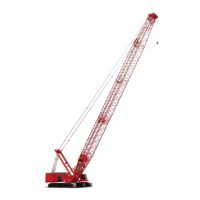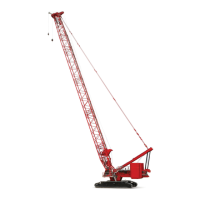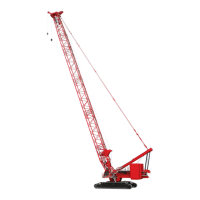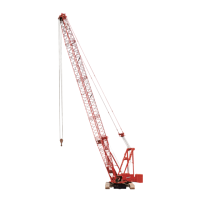Manitowoc Published 11-22-17, Control # 257-02 5-23
MLC300 SERVICE/MAINTENANCE MANUAL HOISTS
Neutral
When drum 6 joystick J1 is moved back to neutral, the pump
swashplate shifts to neutral, stopping hydraulic flow in the
open-loop circuit. The motor swashplate then goes to
maximum displacement, and the drum 6 brake release
solenoid valve (11) de-energizes, opening a return path to
the tank. The brake pressure vents to the tank via the brake
defeat valve (19) and the brake release solenoid valve,
allowing spring force to apply the drum brake (14).
When in neutral, the load-holding valve (9) closes to block oil
flow from the hydraulic motor (15).
If hydraulic pressure is lost on the low-pressure side of the
hydraulic motor during operation, the brake defeat valve
closes, venting the drum brake pressure directly to the tank.
This allows the drum brake to immediately apply to stop the
drum.
Drum 6 Lowering Operation
The following conditions must be met to operate drum 6:
• Seat safety switch must be closed
• Drum 6 must be un-parked
When drum 6 joystick J1 is pushed forward to lower the
luffing jib, the CCMC11 control module sends an electrical
signal to the drum 6 system B control valve (7). The control
valve shifts to a position that routes hydraulic fluid to the
lower side of the system.
The CCM-10 control module then sends a pulse-width
modulated (PWM) signal to the electronic displacement
control (EDC) on pump 3 (3). The PWM signal is in
proportion to the speed commanded by the joystick.
Increasing the PWM duty cycle increases the pump’s
swashplate angle, which increases the hydraulic flow from
the pump through the B port of the drum 6 system B control
valve (7), then to the sequence valve (22) on the A side of
the hydraulic motor (15).
The oil flows through the check valve in the sequence valve
to the A port of the hydraulic motor, causing the motor to
attempt to turn the drum.
At the same time, the IOLC33 control module sends 24 V
DC
to the brake release solenoid valve (11), energizing the
solenoid. The brake valve shifts to a position that routes
hydraulic fluid from the pump 1 charge pump (5) to the brake
defeat valve (19). Hydraulic pressure on the A side of the
motor shifts the brake defeat valve (19). This allows the
hydraulic fluid to flow from the brake release solenoid valve
to the drum brake (14), releasing the brake.
As the motor starts to rotate, hydraulic pressure on the B
side of the motor shifts the load-holding valve (9) to the open
position, allowing the load-holding valve to meter the return
hydraulic fluid as it flows back to the tank via the drum 6
system B control valve. This allows the drum to turn in the
direction that lowers the luffing jib.
The CCM-10 control module then sends a signal to the
IOLC32 control module via the CAN Bus to ramp up the
PWM duty cycle to the drum 6 motor controller. Increasing
the PWM duty cycle decreases the swashplate angle in the
motor, which increases the motor flow until the rotational
speed is maximized based on the pump flow.
The following sensors provide feedback to the controllers:
• Drum 6 Motor Speed Sensor
• Pump 3 Pressure Transducer
(pump 3 system B psi)
• Drum 6 Motor Pressure Transducer
(drum 6 motor psi)
• Drum 6 System B Pressure Transducer
(system B manifold psi)
The control system uses this feedback to adjust the pump
and motor flow to maintain the speeds commanded by drum
6 joystick J1.
Brake Defeat Valve
When the hydraulic system is operating properly, the
pressure on the A side of the motor should always be above
5 bar (73 psi).
The brake defeat valve (19) overrides the brake release
solenoid valve (11) to do the following:
• Prevent the brake from releasing (when applied) if
pressure on the A side of the motor is below 5 bar
(73 psi)
• Apply the brake (when released) if pressure on the A
side of the motor drops below 5 bar (73 psi)
High Pressure Protection
The relief valve (8) protects the hydraulic pump 3 (3) and
motor (15) from a pressure spike such as might occur when
bringing the boom to a sudden stop. The valve is factory set
at the specified pressure.
Drum 6 Cavitation Protection
When needed, the makeup check valves (16) open to allow
fluid stored in the makeup accumulator (17) to enter the low-
pressure side of the system, thereby maintaining a positive
pressure at the motor A port.
Drum 6 Motor Case Protection
The accumulator (18) connected to the motor case protects
the motor from damage due to thermal expansion during
drum storage/transport. If the pressure in the motor
increases, the pressure is captured in the accumulator.

